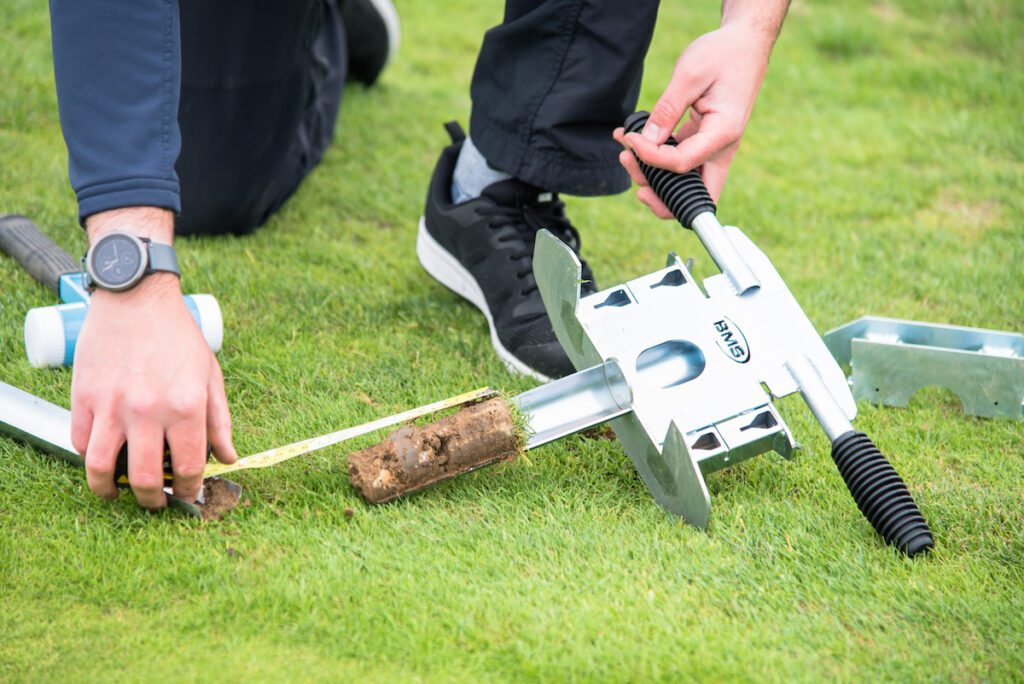The Grounds Management Association (GMA) represents professional and volunteer grounds staff and partners with four sport National Governing Bodies (NGB) for rugby union, rugby league, cricket and football through the GMA’s Pitch advisory service (PAS).
Each of the four dedicated teams work with community clubs, organisations and local authorities to improve the quality of their playing surfaces. Tom Rowley heads the seven-strong contingent for football which, like the other three, works to key performance indicators (KPIs), set by each governing body and the GMA.

Each of the NGB’s have adopted the GMA’s Grounds Management Framework (GMF) in order to set tangible and measurable KPIs. The GMF sets out in an easy-to-digest way the national standards for grass surfaces across football, cricket and both codes of rugby. It explains what skills and knowledge level grounds staff need to achieve these standards.
With the NGBs investing heavily in supporting clubs, along with advice available through the GMA, “there’s never been a better time for grassroots sport to access support for grounds machinery, works and expertise,” says Tom.
Using the Football Foundation’s PitchPower app, clubs input data on machinery, maintenance performance quality standards, grass and weed cover and root depth to allow Tom and his team to grade pitches and provide relevant advice and guidance in order to improve pitch quality. Ten thousand such assessments have been completed since 2020, Tom reveals, with another 1,000 plus face-to-face visits.

Football pitches in England alone number some 40,000, three in four of those grassroots ones, are mostly maintained by volunteers.
“Any club eligible for a Football Foundation grant is expected to put two personnel through the GMA online Level 1 football grounds maintenance course, which lasts four to six hours,” Tom explains – “part of the PAS programme is to upskill groundspeople.”
By the end of May, elite clubs are well into their renovation programmes, although they want to sweat the asset by staging events at stadium sites. “The weather always presents a challenge – perfect conditions are warm, dry with a bit of moisture. A humid atmosphere creates potential for disease.”
Although tempting, grassroots clubs with no access to irrigation should consider holding off major renovation work until September, avoiding the heat of summer potentially, Tom advises.
“Scarifying removes as much thatch and organic material as possible but should only be considered if adequate means of irrigation are available. This should then be followed by applying sand or topdressing – ensuring compatibility with indigenous soil.
“Grassroots clubs with limited budget should apply one to two tonnes of top dressing to low lying or heavily worn areas – this should provide best value,” he adds. Although supply chains have proven challenging, rising prices are making this element of maintenance one of the costliest, even for elite clubs.
“Compaction of playing surfaces is the number one issue at grassroots level and we often witness poorly draining pitches, partly due to the use of heavy rollers, which deprive the grass plant of oxygen and water, aggravated by extensive use. Weeds such as plantains can then populate thinly covered areas or bald patches.
“Deep aeration with solid tines helps decompact pitches by fracturing and fissuring the ground to encourage air pockets – ideally reaching down 200mm and to 100mm spacing. Linear aeration, using horizontal continuous slit vibration is an alternative but can cause cracking in heavy clay soils. Aerating two or three times a year is needed. The majority of grassroots pitches tend to be clay based rather than constructed for football.
“We recommend a dwarf perennial ryegrass mix for overseeding, usually containing at least three different cultivars for wear and disease tolerance, cold weather germination and drought resistance.
“Applying around 35g of seed per square metre is about right for overseeding by hand spreader, drill or tractor-pulled disk seeder – 2 to 3mm into the ground followed by brushing sand dressing into the pitch in three directions to ensure coverage.
“Mid-season renovation is undertaken more by elite clubs,” Tom says. “Our key aim is for pitches to keep good grass cover for longer.” That said, undertaking work “little and often” is a good idea, “and we recommend a mini renovation in September time, when there are still soil temperatures and a bit of moisture.
“Seeds should germinate after a week – irrigation is key at this time but is few and far between at grassroots level. Germination sheets can help retain moisture but if clubs do irrigate, it should be done early morning or in the evening, and ensure deep not shallow watering to access the soil profile adequately.”
Following a soil analysis, Tom advises, if budget allows, applying a pre-seeder fertiliser followed by a controlled or slow-release fertiliser under a phased approach over a three-to six-week cycle, reapplying two or three times a year.
“Irrigate within 48 hours of applying fertiliser. Planning is vital here. Reading the weather is key for grassroots clubs without a watering system. And start planning your renovation in January to ensure your contractor is available when you need them.”
Take care over weed control, Tom cautions. “Broad spectrum selective herbicides need to be applied by fully qualified operators, who are not usually on hand at grassroots level, in contrast to elite clubs. Avoid applying them six to eight weeks either side of seeding. Clover for example flowers in June so it’s prudent to wait until grass establishes, and no mowing three days either side of fertilising, which should always be done in calm conditions and not in drought.”
A former groundsperson at Leicester City FC, Tom is one of the GMA’s leading authorities on football pitch care, applying his in-depth knowledge of sports turf management by helping grounds teams improve football pitch standards nationwide.
For free online groundcare toolkits visit: https://resources.thegma.org.uk
To learn about the GMF visit: https://thegma.org.uk/GMF
And to level up your skills this summer, check out the GMA’s grounds management courses, available online and designed for all levels: https://portal.thegma.org.uk/education/courses/search
Words by Greg Rhodes



